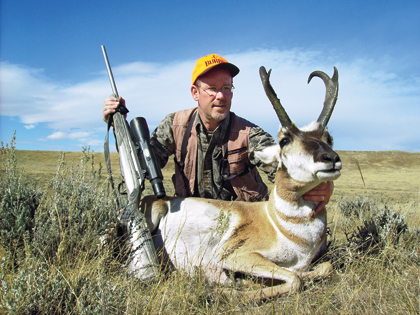
I doubt if anyone living today knows for certain who was the first to neck down the .30-06 case to .25 caliber, but the credit usually goes to gunsmith Adolph Niedner, who owned the Niedner Rifle Corporation of Dowagiac, Michigan.
Niedner called his creation the .25 High Power Special, and his favorite woodchuck load consisted of the 87-grain Sisk bullet pushed from the muzzle at 3,200 fps by 44.0 grains of now-obsolete Hercules No. 20 powder.
The wildcat was created during the early 1920s for varmint shooting, but it did not take big game hunters long to discover it as well. One of the first was oil tycoon F.H. Riggall, who used a rifle built by Niedner to bump off what was described as a very large Canadian grizzly. The handload he used generated 3,000 fps with a 100-grain bullet.
Soon after Niedner introduced his cartridge, other gunsmiths began to chamber rifles for it, and it eventually became more commonly known as the .25-06.
During about the first two decades of its existence, the .25-06 was impressive only in appearance simply because the powders available at the time were too quick in burn rate to push it to its true velocity potential. Back then, varmint shooters did not have chronographs as we do today, but one was not needed to see that the big cartridge shot no flatter at long range than smaller numbers such as the .250-3000 Savage and the .257 Roberts.
That changed during the 1940s when a fellow out in Kansas named Bruce Hodgdon started buying boxcar loads of military surplus powder and selling it to handloaders.One of those propellants was identified by the U.S. government as IMR-4350 Data Powder, and we know it today as H4831. Suddenly, Adolph Niedner’s fine old cartridge gained upwards of 300 fps in muzzle velocity. If not for Bruce Hodgdon, many of us would not be reloading cartridges today, and if not for his introduction of H4831, the .25-06 might have simply faded away.
Going Legit
/>
When it comes to making honest cartridges of wildcats, nobody has done it as many times as Remington, so it was only fitting that the guys in green made it a factory cartridge and started offering ammunition in 1969. Introduced in the Model 700 and 40X rifles, the .25-06 was initially loaded with 87- and 120-grain bullets at advertised velocities of 3,500 and 3,120 fps.
Before long, a 100-grain bullet at 3,230 fps was added. Claimed velocity for factory ammo with that bullet weight has remained the same through the years, but the 120-grain loading has been throttled back to 2,990 fps.
The 87-grain loading was always a slow seller for Remington simply because most rifles in .25-06 are used for hunting big game rather than varmint shooting, and between the two, the 120-grain load consistently outsells the 100-grain load. A variety of options are also offered by Hornady, Federal and Winchester.
Through the decades I have burned more H4831 in various rifles chambered for the .25-06 than any other powder, but during the past few years some of the rifles I have tried have been equally happy with Reloder 22 and Hodgdon’s Retumbo. Those two work especially well when loaded behind bullets weighing 115 grains and heavier. Other fine candidates for handloads include H1000, Western Magnum, Norma MRP, VitaVuori N165, IMR-7828 and Supreme 780 from Winchester.
I first hunted with the .25-06 during the early 1960s using a rebarreled 98 Mauser action, but today I have a Cooper Model 52, the most accurate and most handsome rifle in .25-06 I have ever held in my hands.
If a huge bull elk were standing across a canyon and the rifle in my hands was chambered to .25-06, I would feel confident in making the shot with the right load but am quick to admit that the cartridge is best suited for use on smaller game. It is at its very best when used on deer-size game in open country and, for that, few cartridges are as good and even fewer are better.
The .25-06 has low recoil, shoots flat and delivers plenty of punch at long range for game such as whitetail deer, mule deer and pronghorn antelope. In a good rifle, it is capable of excellent accuracy.
Like the majority of hunters who use this cartridge on big game, I have always preferred bullets weighing from 115 to 120 grains, but there is no law against heading to the hills with a magazine full of 100-grain deer medicine.











































